Players celebrate inclusion at USA Hockey Sled Classic
Game brings together those with different backgrounds, skill levels at tournament presented by NHL
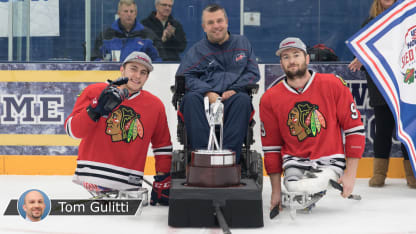
A few latches had to be opened before the top of the crate was removed to unveil the precious cargo, the O'Connor Courage Trophy, which was awarded at the end of the weekend to the Tier I champion at the USA Hockey Sled Classic, presented by the NHL.
This was the eighth year of the tournament, which was held Nov. 16-19, but the first time the winner of its top tier received a trophy. Seeing it for the first time, its namesake, USA Hockey Disabled Section chair J.J. O'Connor, was speechless at first.
"They really delivered," he finally said. "It's beautiful."
A gift from the NHL, the 28-pound trophy features a birch wood base topped by a sled and crossed sticks made of polished, machined silver aluminum. Attached to the base are seven metal plates, engraved with the names of the winning Tier I teams, and their players, from the first seven Sled Classics.
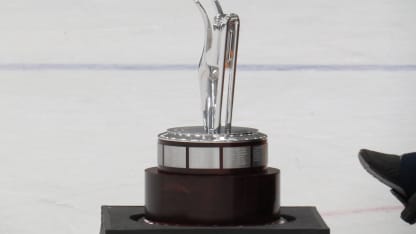
After the 2017 winner's plate is added, the O'Connor Courage Trophy will be displayed at the Hockey Hall of Fame in Toronto.
"With the NHL getting involved and making a trophy like that and having J.J.'s name on it and everything, it's tremendous," said Adam Page, a forward on the U.S. National Sled Hockey Team. "And to see him get rewarded and recognized is pretty cool."
Paralyzed from the neck down since crashing headfirst into the boards while playing hockey when he was 16, O'Connor, 38, has dedicated his life to helping others play the sport he loves. The resident of Mount Prospect, Illinois, has been in his volunteer position with USA Hockey since 2002.
He has made an impact near his home, where he founded a sled hockey program, the Chicagoland Hornets, in 2003, and internationally.

O'Connor was general manager of the U.S. team that won the gold medal in para ice hockey (as sled hockey is known internationally, having formerly been called sledge hockey) at the 2010 Vancouver Paralympics and was the family and friends coordinator when the United States won again at the 2014 Sochi Paralympics.
Since starting the Sled Classic with four teams in 2010, he's overseen its growth into a premier sled hockey tournament. This year's field included a record 28 teams representing 20 NHL franchises across five tiers of competition (seven League teams were accounted for more than once). There were more than 300 players, male and female, wearing NHL-licensed jerseys.
The players come from different backgrounds, but that doesn't matter once they're on the ice. Like with any able-bodied player, it's about the game, not how they got there.
This is the embodiment of the NHL's Hockey is for Everyone initiative.
"We've got a lot of [military] veterans and most on our team are some type of amputee, so we've all got a story," said William "Wolf" Hulslander, a forward on the Carolina Hurricanes Tier IV sled team and a double amputee. "But it doesn't make a difference when we're on the ice. We're all the same."
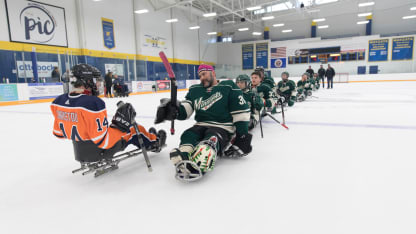
© JARED WIESELER
O'Connor takes pride in the diversity of the competitors with their "melting pot of abilities" and the role he played in bringing them here, but believes he's unworthy of having his name on a trophy.
USA Hockey president Jim Smith, who befriended O'Connor in the days following his accident on Oct. 24, 1995, said he couldn't think of a better representative of what the trophy symbolizes.
"When I heard about it, I said that's probably apropos it's named after him because his courage, dedication and passion made this reality," Smith said. "I don't think there's anybody else that's even come close."
\\*
Perhaps superstitious, though his name was already on the O'Connor Courage Trophy twice from winning the Sled Classic with the Buffalo Sabres in 2011 and 2013, Page had no interest in touching it the day it arrived at Plymouth Ice Center. He hoped to get his name on there again, but the Sabres failed to advance past the round-robin stage.
He likes the idea of the trophy being on display at the Hall of Fame, though. There visitors from around the world will have a chance to see it and learn about sled hockey.
Born with spina bifida, a birth defect that occurs when the vertebrae don't form properly around the spinal cord, the 25-year-old Page is paralyzed from the shins down in both legs. He started playing sled hockey when he was 6.
"We were just lucky enough to find a program in Buffalo," he said. "There was a flyer at one of my doctor's appointments and I happened to see it. When I got on the sled for the first time, I was hooked. It felt like I was playing hockey, except sitting down."
[Courtesy of Wild TV]
That, of course, is the main difference between sled hockey and stand-up hockey: Players sit in adaptive sleds with skate blades on the bottom. They use two shortened sticks with blades on one end to handle, pass and shoot the puck, and metal picks on the butt end that allow them to push the sled across the ice.
When played at the highest level, the speed, precision and physicality of sled hockey echoes the best of the stand-up game.
Top players such as Page can pass and shoot with both hands, flipping their sticks from the pick end to the blade end before shooting the puck with stunning power and accuracy.
"We've had a lot of NHL players that have tried this sport and our guys just skate circles around them," Smith said. "It's kind of humbling for our pros. In Chicago, I've had [Chicago Blackhawks forwards] Patrick Kane and Jonathan Toews out there in a sled and they're getting whipped around by 15- and 16-year-olds."
The most surprising element for those who haven't seen the sled game before might be the checking. Players ram their sleds into opponents to knock them off the puck in open ice or ride them into the boards.
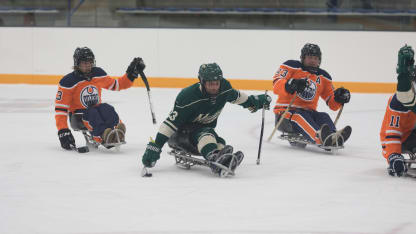
© JARED WIESELER
"We're getting checked with metal bumper cars, basically," said U.S. defenseman Josh Pauls, who played for the St. Louis Blues at the Sled Classic. "Even the accidental contact a lot of times really can affect you because you don't expect it and then, boom! You get hit by a train."
Pauls, the U.S. captain, and Page were among 15 players from the national team to play in the Sled Classic. Page was 15 when he first made the national team in 2007.
He's played in the World Para Ice Hockey Championships six times, winning gold medals in 2009, 2012, 2015. He also won gold at the 2010 Vancouver Paralympics and 2014 Sochi Paralympics, and dreams of getting another at the 2018 PyeongChang Games from March 8-18.
After Page returned from Sochi, he was recognized by some fans at the mall who had watched the United States' 1-0 victory against Russia in the gold-medal game, which was televised live on NBC.
That reminded him that, though he views himself as a regular guy playing a sport he loves, he can have an impact by gaining acceptance for the sport and inspiring others to play.
"There's been some powerful things that have happened from talking to kids at schools and around the country and even just locally that made me really realize it's something bigger than just hockey and something more that we represent," Page said. "The cool thing about sled hockey is really anybody can play. There's a level for anyone to play at no matter how low or high your disability is."
\\*
In 2013, Jack Hooker was lying in a hospital bed recovering after losing his left leg below the knee and the inside third of his right foot. He was thinking about two things. One was figuring out how he was going to shift gears on his motorcycle.
The other was his Halloween costume.
"I had to be a peg-leg pirate for Halloween," Hooker said. "And I was. I got a little wooden peg that goes right on the bottom."
That's how quickly acceptance came for Hooker, who normally wears a prosthesis instead of the peg on his left leg.
Being a Type 1 diabetic, Hooker knew he was at risk of losing a foot or a leg. The poison from a bite by a brown recluse spider turned out to be the trigger.
"I was not able to fight it off," Hooker said. "I spent 95 days in the hospital with my body being septic and all kinds of crazy stuff."
Four years later, Hooker remains active. He picked up sled hockey less than a year ago, and, at age 56, was one of the oldest players at the Sled Classic.
Hooker's team, the Grand Rapids Sled Wings, combined with the Michigan Sled Dogs (from Fraser, Michigan) to give the Detroit Red Wings a representative in the Sled Classic for the first time. The Red Wings were eliminated by the Minnesota Wild in the Tier III semifinals, but that didn't take away from Hooker's enjoyment of the weekend.
"You see all different talents, but everybody comes together," the forward said. "There isn't anybody that you can't walk up to, including the guys from the national team. At different events we've been at, they're happy to talk to you."
Hooker has tried other adaptive sports, such as hand cycling, but enjoys the camaraderie that comes with being on a team.
"My hockey team was actually the first group of amputees that I really got to be with," he said. "From playing rugby and stuff [when he was younger], I'm very accustomed to the team atmosphere and that's what it is. Nobody cares what your [background] is. If you can't reach down and grab what you need, somebody comes and hands it to you. Everybody is accepting."
Hulslander has had similar experience with his local sled team, the Cat 5 Canes, based in Raleigh.
"I was in the Marine Corps," Hulslander said. "I got out in 1985. In team sports, you get that [feeling] a little bit."
Like Hooker, Hulslander is older (54) and relatively new to sled hockey. He started playing three years ago after seeing the Cat 5 Canes do a demonstration in his hometown of Greenville, North Carolina.
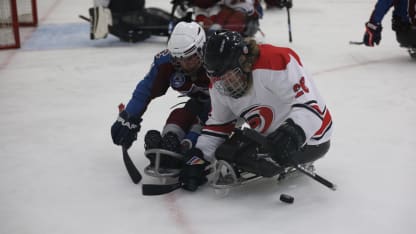
Hulslander had both legs amputated above the knee after a 2,000-pound hydraulic lift fell on him while he was working at a yarn-spinning company on June 6, 1999. Since then, Hulslander hasn't liked wearing his prostheses, but would sometimes put them on to participate in 5K charity races to prove there is life after amputation.
Wheelchair sports never appealed to him. In sled hockey, he found a freedom he'd been missing.
"The mobility of being on the ice, being able to go left or right and get around and you're not encumbered with prosthetics and all this other stuff, that was fun," he said. "Plus, I like hitting people."
\\*
At 4-foot-11, 99 pounds, Kelsey DiClaudio is used to being the smallest player on the ice, especially when she's playing alongside and against men. So the Pittsburgh Penguins forward wasn't intimidated when Edmonton Oilers defenseman Tanner Fandrey nearly ran her over with his sled during the opening game in the Tier II tournament.
Fandrey (5-10, 150), a member of Canada's 2017 National Sledge Development Team, received a boarding penalty. DiClaudio quickly bounced back up and finished with three assists in a 6-4 loss.
"Canadians tend to be a little bit more physical," DiClaudio said.
Not that she minds that.
"I've been playing with the guys since I was 8 and it's a respect thing, too," she said. "If they didn't treat me the same way on and off the ice, that's disrespectful to me. Hit me as hard as you're going to hit some other guy. Treat me like one of the guys."
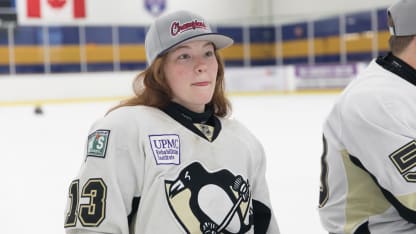
© JARED WIESELER
Of the 1,332 sled hockey players who registered with USA Hockey for the 2016-17 season, 228 were females. So DiClaudio often has no choice but to be one of the guys.
The 20-year-old was the first woman to be selected to the U.S. Development Sled Hockey Team and played on it for three seasons before failing to make the final cut at tryouts for the national team this past summer. That ended DiClaudio's dream of playing in PyeongChang.
With no women's tournament, para ice hockey was changed from men's to coed prior to the 2010 Vancouver Paralympics, but no woman has competed in the sport at the Paralympics.
"I've been told by national team coaches that, 'If you were male, you'd be playing for me'," DiClaudio said. "And that's kind of a dagger right to the heart."
U.S. coach Guy Gosselin said that DiClaudio is probably the top female player in the world. He said she was evaluated like the other 64 players who tried out, but didn't get one of the 17 spots.
"She's got an excellent skill set," Gosselin said. "We look at strength as well and stability out on the ice. There's so many different factors that come into play. ... We picked what we thought was the best hockey team and the most competitive team."
DiClaudio, who was born with tethered spinal cord syndrome but was able to walk until having surgery to reduce her pain when she was 15, isn't easily deterred. She's turned her hopes now to women's para ice hockey being included in the Paralympics, possibly as soon as the 2022 Beijing Games.
The problem is that outside of the United States and Canada, there aren't enough female players to put together a full tournament. In 2014, the International Paralympic Committee (IPC) held an Ice Sledge Women's Hockey International World Cup in Brampton, Ontario, with three teams: the United States, Canada and Europe. DiClaudio helped the United States win by scoring four goals in a 5-1 victory against Canada in the final.
The IPC is planning another World Cup at a European site to be determined in May 2018. Though DiClaudio's hope is that women's para ice hockey can at least be a demonstration sport at the 2022 Beijing Paralympics, Smith estimated that it would take at least a decade for it to become a Paralympic event because the IPC would likely require several World Cups or World Championships first.
On the positive side, Smith said USA Hockey, which previously has supported the U.S. Women's National Sled Hockey Team through a grant, plans to make it one of its official programs next year.
Meanwhile, DiClaudio continues to excel playing against men in what she called "the most amazing sport out there." In a rematch with Edmonton in the Tier II semifinals, she had two goals and an assist in a 4-2 win. She then assisted on both Penguins goals in a 3-2 shootout victory against the Columbus Blue Jackets in the final.
\\*
Sarah Bettencourt, a U.S. women's national team forward who played for the Anaheim Ducks Tier IV team at the Sled Classic, has been among those pushing to get women's para ice hockey added to the Paralympics. As chair of what she called "kind of like a subcommittee for international women's para ice hockey development," Bettencourt worked with the IPC to help put together a women's development camp in Chuncheon, South Korea, in October and has been involved in the planning for the 2018 World Cup.
A former U.S. Marine Corps captain and helicopter pilot who was forced to retire in 2012 because of a neurological disorder that took her ability to walk, Bettencourt, 34, has found a new focus for her organizational and leadership skills since participating in a sled hockey clinic in 2014.
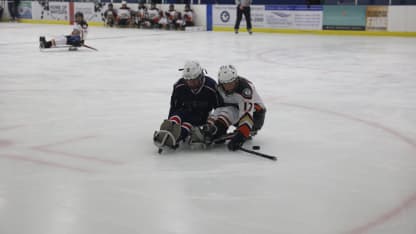
"I was sold the first time I got on the ice," she said. "I was flying on the ice and I loved it."
When she returned home to San Diego, Bettencourt wanted to play on a team. So she started one, the San Diego Ducks.
She began by asking some local rinks to provide ice time. Then, she went to the Anaheim Ducks, who immediately offered their support, including providing jerseys. USA Hockey helped with its sled lending program and by holding a sled hockey clinic.
After starting with a handful of players, Bettencourt said the San Diego Ducks have 30-35 in their adult and youth programs. The payoff for her has been in physical and recreational therapy.
"It's given me another family," Bettencourt said. "It's given me that team, that feeling that I need. I was a captain in the Marine Corps. I led hundreds of Marines, and going from that to absolutely nothing I felt like I lost my ability to serve our society. So by forming our own club in San Diego, it's given me a sense of purpose. It's allowed me to go back and serve again."
Although about half the players in the San Diego Ducks adult program are former military members, they are not a USA Warriors team. The USA Warriors, who have sled and stand-up programs, also use hockey as recreational, therapeutic tool, but are strictly for those injured while serving in the military.
The Sabres and Colorado Avalanche each had USA Warriors teams competing in the Tier V tournament at the Sled Classic, and USA Hockey is organizing a Warrior Classic for wounded veterans to be held in Las Vegas, possibly as soon as 2018. (Las Vegas-based entertainer Terry Fator is helping to provide funding with a grant through his foundation.)

Bettencourt said she fully supports the USA Warriors, but believes that playing alongside civilians aids the transition from military to civilian life. For many wounded veterans, however, being among other veterans provides a support civilians can't.
"I played on a baseball team for a little while and there were no vets," said David Cross, a former U.S. Army sergeant and current forward for the Sabres' USA Warriors team. "They asked a lot of questions that people don't know not to, that these vets would know. Or if I do talk to them, I'm comfortable because they know."
Cross's right leg was injured by an improvised explosive device when he was serving in Afghanistan in October 2009. After six years of surgical attempts to reconstruct the leg, Cross elected to have it amputated, a decision he said was "probably the best thing ever."
But Cross initially struggled in his return to civilian life. Four years ago, one of his counselors suggested he try sled hockey as an outlet.
"I know there's amputees who do sports and things like that, but I didn't really know what I wanted to do," Cross said. "I couldn't figure it out, so I was getting frustrated at home. Once I found this and I found good people, I have really good friends on this team, then it almost made me relax. I was able to relax again."
\\*
On Feb. 14, 2007, U.S. Marines Lance Cpl. Travis Dodson was in Iraq when a grenade was tossed into the second-story room where he was staying. He lost his left leg at the hip and right leg below the knee. As a double amputee and military veteran, he initially found his outlet in individual adaptive sports such as wheelchair racing and cross-country skiing.
Dodson competed at the 2014 Sochi Paralympics in cross-country skiing and biathlon. While he was there, he watched the United States defeat Russia in the para ice hockey gold-medal game.
At that moment, he decided this was the sport he wanted to play. A friend in Chicago who volunteered for the Blackhawks sled hockey team asked if he'd like to come out to practice and try it.
"I started it and I was hooked," he said. "Then, I decided this is what I want to pursue."
Less than four years later, Dodson, 32, is a forward on the U.S. National Sled Hockey Team and one of the best players on the Blackhawks Tier I team. In the Sled Classic final against the Avalanche, Dodson scored three goals, and U.S. teammate Brody Roybal, also a forward, had three goals and two assists in the Blackhawks' 7-1 victory.
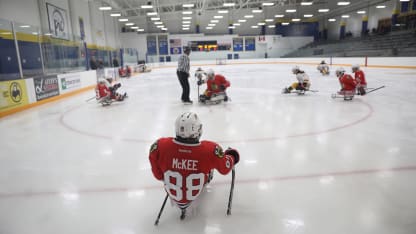
Afterward, they became the first team to receive O'Connor Courage Trophy as Sled Classic Tier I champions. A plan to attach the customized trophy stand to the back of the players' sleds so they could celebrate by taking turns towing it around the ice fell through when the stand kept breaking free from the latch.
"That didn't work too well," said Dodson, the first to try towing the trophy. "But that would have been cool to pull it around the rink to celebrate."
The Blackhawks players settled for posing for pictures while lifting the trophy over their heads.
"We've never seen anything that cool before," Roybal said. "Usually, it's just the hats and the banner [for the winning team]. But to have a trophy you can hold in your hands is awesome."
Watching from the ice in his motorized wheelchair, O'Connor was smiling proudly. Some of the Blackhawks players got their start in the Hornets program he founded.
Though O'Connor has some feeling and movement in his body, he doesn't have enough upper-body mobility to play sled hockey. That's left him to channel all his energy into helping others play the sport, which is a life purpose he finds quite satisfying.
It's also helped get his name on a trophy that will be displayed in the Hall of Fame.
"Now looking back, I realize this is probably better this way," O'Connor said. "Because if I played, I might have just been the typical hockey player that played men's league hockey and didn't really have the involvement. I found that in my position the more I can do that maybe helps somebody else that wouldn't have had a chance to play, and if I could to put a smile on somebody else's face to enjoy the game, I actually get more enjoyment out of it than I would have if I was just playing.
"So the giving back and the watching others enjoy the game, it's like I'm living through their enjoyment and that creates greater enjoyment for me personally."

© JARED WIESELER

















